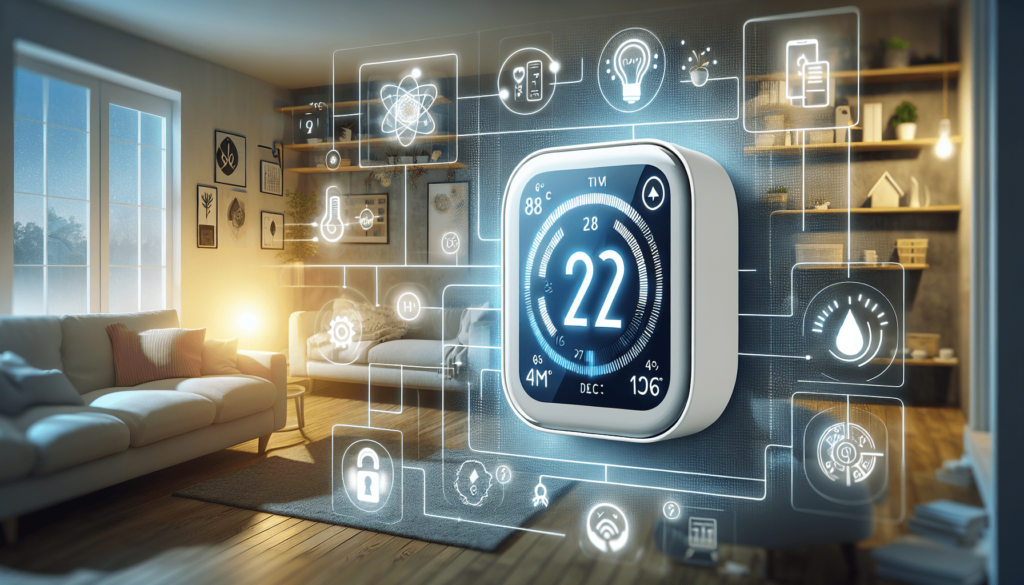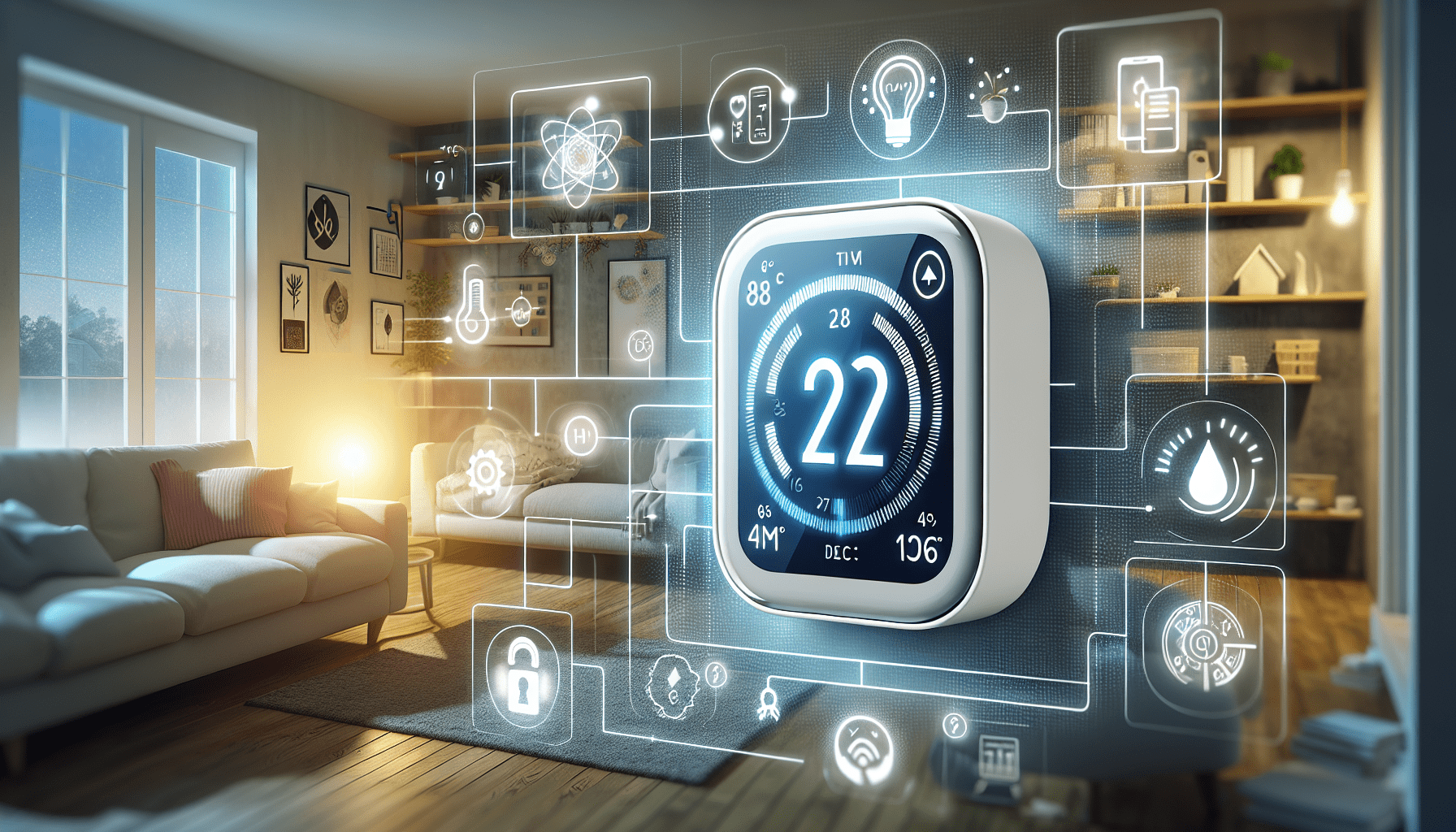So you’ve recently upgraded to a smart thermostat and are eager to make the most out of its features, including the ability to schedule temperature changes. But you may be wondering, “How do I actually do that?” Thankfully, scheduling temperature changes with a smart thermostat is a breeze and can greatly improve the comfort and energy efficiency of your home. In this article, we’ll guide you through the simple process of setting up temperature schedules, allowing you to effortlessly maintain the perfect climate for your lifestyle.

1. Understanding Smart Thermostats
1.1 What is a smart thermostat?
A smart thermostat is a device that allows you to control and schedule the temperature of your home using advanced technology and features. Unlike traditional thermostats, which require manual adjustment, smart thermostats offer greater convenience, energy efficiency, and customization options. These devices can be controlled remotely through Wi-Fi connectivity and can often be integrated with other smart home devices, such as voice assistants and smart lighting systems. Smart thermostats can learn your preferences over time and adjust the temperature accordingly, providing a more comfortable and efficient living environment.
1.2 Benefits of using a smart thermostat
Using a smart thermostat offers several benefits beyond traditional thermostat options. Firstly, it allows you to schedule temperature changes throughout the day, ensuring that your home is always at the desired temperature without the need for manual adjustments. This not only improves comfort but also helps save energy and reduce utility bills. Secondly, smart thermostats often come with energy-saving recommendations and insights, providing you with valuable information on how to optimize your temperature settings for maximum efficiency. Additionally, these devices can be controlled remotely using a smartphone app, allowing you to make adjustments even when you’re away from home. Overall, smart thermostats offer convenience, energy savings, and the ability to customize your home’s temperature settings to suit your lifestyle.
1.3 Types of smart thermostats
There are various types of smart thermostats available on the market. Some of the most common types include:
Programmable thermostats: These thermostats allow you to set temperature schedules for different times of the day or week. They offer basic scheduling capabilities but may not have advanced features like learning algorithms or Wi-Fi connectivity.
Learning thermostats: These thermostats use machine learning algorithms to analyze your temperature preferences and create automated schedules accordingly. Over time, they can adapt to your routine and make adjustments to optimize comfort and energy efficiency.
Geofencing thermostats: Geofencing thermostats use your smartphone’s location to determine whether you’re home or away. They can automatically adjust the temperature based on your location, ensuring that your home is always at the desired temperature when you arrive.
Wi-Fi thermostats: Wi-Fi thermostats allow you to control your home’s temperature remotely through a smartphone app. They often come with additional features like energy monitoring, weather integration, and voice control capabilities.
Understanding the different types of smart thermostats can help you choose the one that best fits your needs and preferences when it comes to scheduling temperature changes and optimizing energy efficiency.
2. Setting Up a Smart Thermostat
2.1 Compatible systems
Before purchasing a smart thermostat, it’s essential to ensure that your current heating and cooling system is compatible with the device. Different smart thermostats work with different HVAC systems, so it’s crucial to consult the manufacturer’s specifications or seek professional advice if you’re unsure. Generally, most smart thermostats are designed to work with standard HVAC systems found in residential homes, such as forced-air systems, heat pumps, and central heating and cooling systems.
2.2 Installing the smart thermostat
Once you’ve determined compatibility, installing a smart thermostat is relatively straightforward. Most manufacturers provide installation instructions along with the device, and many also offer detailed video tutorials for guidance. It typically involves turning off power to the heating and cooling system, removing the old thermostat, attaching the wires to the corresponding terminals on the smart thermostat, and mounting it on the wall. However, if you are uncomfortable with electrical work, it’s always best to hire a professional to ensure a proper installation and avoid any potential hazards.
2.3 Connecting to Wi-Fi
One of the key features of a smart thermostat is its ability to connect to Wi-Fi, allowing you to control the device remotely through a smartphone app or web interface. To connect your smart thermostat to Wi-Fi, you’ll need to follow the instructions provided by the manufacturer. Typically, this involves accessing the thermostat’s settings menu, selecting the Wi-Fi network you want to connect to, and entering the network password. Once connected, your thermostat will be able to receive commands and send information wirelessly, enabling you to control it from anywhere with an internet connection.
2.4 Registering and configuring the device
After your smart thermostat is installed and connected to Wi-Fi, you may need to complete a registration process and configure the device according to your preferences. This usually involves creating an account with the manufacturer’s app or web interface, entering information such as your location, and customizing your temperature settings and schedule preferences. Registration and configuration processes may vary depending on the brand and model of the smart thermostat, so it’s essential to follow the manufacturer’s instructions carefully.

3. Exploring Temperature Scheduling Features
3.1 Understanding temperature schedules
Temperature schedules are a core feature of smart thermostats. They allow you to set specific temperature preferences for different times of the day, ensuring that your home is comfortable when you need it to be while optimizing energy usage when you’re away or asleep. Temperature schedules can be pre-programmed or learned by the thermostat itself, depending on the type of device you have.
3.2 Creating a basic schedule
To create a basic temperature schedule, you’ll need to access the settings menu on your smart thermostat or the associated smartphone app. From there, you can set the desired temperature for different times of the day, such as morning, afternoon, evening, and nighttime. For example, you might want your thermostat to automatically increase the temperature in the morning to wake you up comfortably, decrease it during working hours when nobody is home, and warm it up again for your arrival in the evening. By setting a basic schedule, you can ensure optimal comfort and energy efficiency throughout the day without the need for manual adjustments.
3.3 Adjusting temperatures for different times of the day
In addition to setting a basic schedule, smart thermostats often allow you to further adjust temperatures for specific times of the day. For example, you can program your thermostat to lower the temperature during the afternoon when the sun is at its peak, and then raise it again in the evening when the outside temperature cools down. These adjustments can help maintain a comfortable indoor climate while minimizing the need for excessive heating or cooling.
3.4 Setting different schedules for weekdays and weekends
Many smart thermostats offer the flexibility to set different temperature schedules for weekdays and weekends. This feature is particularly useful if your routine varies significantly between workdays and leisure days. For example, you can program your thermostat to follow a more energy-efficient schedule during weekdays when you’re away for most of the day, and a more comfortable schedule on weekends when you’re spending more time at home.
3.5 Utilizing vacation or away mode
When you’re away from home for an extended period, such as during vacations, smart thermostats offer a vacation or away mode. This feature allows you to set a temperature schedule specifically for when you’re not at home. For example, you can set a lower temperature during the winter to prevent freezing pipes or a higher temperature during the summer to prevent excessive humidity. By utilizing the vacation or away mode, you can ensure that your home remains in an optimal condition while saving energy and avoiding unnecessary heating or cooling.
4. Advanced Scheduling Options
4.1 Using geofencing for automatic temperature adjustments
Imagine arriving home after a long day, and your smart thermostat has already adjusted the temperature to your preferred setting. With geofencing, this scenario becomes a reality. Geofencing relies on your smartphone’s location to determine when you’re approaching home. When your smartphone enters a specified radius around your home, the smart thermostat detects this and automatically adjusts the temperature to your desired setting. This feature ensures that your home is always comfortable upon your arrival, without the need for manual adjustment or waiting for the thermostat to respond.
4.2 Integrating with voice assistants for voice-controlled scheduling
Voice assistants, such as Amazon Alexa or Google Assistant, can be integrated with smart thermostats to provide voice-controlled scheduling capabilities. With this integration, you can simply give voice commands to adjust the temperature or set schedules, making it even more convenient to manage your home’s climate. You can utilize voice assistants to change the temperature, switch between different temperature schedules, or activate specific modes like vacation or away mode. Voice control offers hands-free convenience, allowing you to control your thermostat even when your hands are full or when you’re in another room.
4.3 Connecting with weather services for adaptive schedules
Some smart thermostats can connect with weather services to receive real-time weather information. By integrating with weather services, your thermostat can adjust its temperature schedule based on current weather conditions. For example, if it’s a particularly cold day, your thermostat can automatically increase the temperature slightly to compensate for the outdoor chill. Similarly, on a hot day, the thermostat can adjust the temperature lower to maintain a comfortable temperature indoors. By incorporating weather data into the scheduling algorithm, smart thermostats can adapt to changing climatic conditions and optimize energy usage accordingly.

5. Tips for Efficient Temperature Scheduling
5.1 Understanding energy-saving recommendations
Most smart thermostats provide energy-saving recommendations and insights based on your temperature settings and usage patterns. It’s important to pay attention to these recommendations as they can help you optimize energy usage and reduce utility bills. They may suggest adjustments such as lowering the temperature by a few degrees during certain hours or avoiding temperature extremes. By following these recommendations, you can maintain comfort while maximizing energy efficiency.
5.2 Scheduling temperature setbacks during sleep or work hours
During sleep or work hours, when occupants are less active or away, it’s beneficial to schedule temperature setbacks. Temperature setbacks involve adjusting the temperature slightly lower during these periods to conserve energy. For example, you can set the temperature lower during the night when you’re sleeping or during the day when you’re away at work. By scheduling temperature setbacks, you can achieve energy savings without sacrificing comfort, as your smart thermostat will automatically readjust to your preferred temperature before you wake up or return home.
5.3 Taking advantage of remote control and manual overrides
Smart thermostats offer the convenience of remote control, allowing you to make temperature adjustments even when you’re not at home. This feature can come in handy if your schedule changes unexpectedly, or if you want to ensure that your home is at the desired temperature before your arrival. Additionally, most smart thermostats allow for manual overrides, allowing you to make immediate changes to the temperature without affecting the programmed schedule. By taking advantage of remote control and manual overrides, you have complete control over your home’s climate, ensuring your comfort and energy efficiency.
5.4 Monitoring energy usage and adjusting schedules accordingly
To further optimize your temperature scheduling, it’s beneficial to monitor your energy usage and make adjustments accordingly. Many smart thermostats provide energy usage reports or insights through their associated apps or web interfaces. By reviewing this data, you can identify patterns, such as periods of excessive energy consumption, and make informed decisions about adjusting your temperature schedules. For example, you may notice that your energy usage is high during certain hours, indicating a need for a lower temperature setting during those times. By regularly monitoring energy usage and adjusting schedules accordingly, you can continually refine and improve the efficiency of your smart thermostat.
6. Troubleshooting and Common Issues
6.1 Smart thermostat compatibility issues
While smart thermostats are designed to work with a variety of HVAC systems, compatibility issues can still arise. If you experience compatibility issues, it’s important to consult the manufacturer’s documentation or contact their customer support for guidance. They may be able to provide specific instructions or recommend compatible models for your system. In some cases, professional installation or system upgrades may be necessary to ensure compatibility.
6.2 Wi-Fi connectivity problems
Wi-Fi connectivity is essential for the proper functioning of a smart thermostat. If you’re experiencing Wi-Fi connectivity problems, there are a few troubleshooting steps you can take. Start by checking your internet connection and ensuring that your Wi-Fi network is functioning correctly. Verify that your smart thermostat is within the range of your Wi-Fi router and that there are no physical obstructions blocking the signal. If the connectivity issues persist, you may need to reset your smart thermostat or contact the manufacturer for further assistance.
6.3 Incorrect temperature readings or malfunctions
If your smart thermostat is displaying incorrect temperature readings or experiencing malfunctions, there are a few possible causes. First, check if the thermostat is placed in an accurate location away from direct drafts or heating sources that may affect temperature readings. Ensure that the thermostat’s temperature sensor is clean and free from dust or debris. If the issue persists, rebooting or resetting the thermostat may solve the problem. If none of these steps resolve the issue, it’s advisable to contact the manufacturer’s customer support for further troubleshooting or to inquire about possible warranty coverage.

7. Integrating Other Smart Home Devices
7.1 Connecting with smart lighting systems
To enhance the automation and energy efficiency of your home, consider integrating your smart thermostat with smart lighting systems. By connecting these devices, you can create synergy between temperature and lighting control, ensuring that energy is used efficiently throughout your home. For example, you can program your smart lighting system to adjust brightness or turn off lights when the thermostat detects that you’re away from home. This integration can result in additional energy savings and enhanced convenience.
7.2 Syncing with smart blinds or curtains
Syncing your smart thermostat with smart blinds or curtains can further optimize energy efficiency in your home. By coordinating the opening and closing of blinds or curtains with temperature changes, you can maximize natural light and reduce dependence on artificial lighting and heating or cooling. For example, during sunny hours, your smart thermostat can raise the temperature and simultaneously open the blinds to allow sunlight to heat the space naturally. This integration helps regulate temperature and light levels, ensuring a comfortable and energy-efficient environment.
7.3 Coordinating with smart sensors for enhanced automation
Smart sensors, such as occupancy sensors or window sensors, can be integrated with your smart thermostat to enhance automation and energy efficiency. By connecting these sensors with your thermostat, you can automate temperature adjustments based on occupancy or open window detection. For instance, if the occupancy sensor detects that a room is unoccupied, the thermostat can adjust the temperature accordingly to conserve energy. Similarly, if a window sensor detects an open window, the thermostat can pause or adjust the temperature to prevent wasted energy due to heat gain or loss. Integrating smart sensors with your smart thermostat maximizes convenience and ensures optimal energy usage.
8. Exploring App-Based Control and Scheduling
8.1 Downloading and configuring the smart thermostat app
Most smart thermostats come with a dedicated smartphone app that allows for seamless control and scheduling. To take advantage of app-based control, start by downloading the manufacturer’s app from the App Store or Google Play Store, depending on your device’s operating system. Once installed, open the app and follow the provided instructions to configure the app with your smart thermostat. This typically involves creating an account, entering your device’s serial number, and connecting to your Wi-Fi network.
8.2 Navigating the app interface
Once the app is configured, you can navigate its interface to access various features and settings. The app interface typically provides an overview of your home’s current temperature, displays temperature schedules, and allows for manual adjustments. You may also find additional features, such as energy usage reports, integration options, and settings for advanced scheduling or automation. Familiarize yourself with the app’s interface to make the most of its capabilities and easily manage your smart thermostat from anywhere with an internet connection.
8.3 Setting up temperature schedules through the app
Using the app, you can easily set up and manage temperature schedules for your smart thermostat. Navigate to the scheduling section within the app, and you should find options to create, edit, or delete temperature schedules. Depending on the features of your smart thermostat, you may have additional customization options such as setting different schedules for weekdays and weekends, adjusting temperature setbacks, or utilizing vacation or away mode. Simply follow the app’s prompts to set up your desired temperature schedules, and the smart thermostat will take care of the rest, ensuring your home stays comfortable and energy-efficient.

9. Customizing Temperature Schedules for Different Rooms
9.1 Understanding zone control
Zone control allows you to customize temperature schedules for specific areas or rooms in your home. This feature is particularly useful if different areas have different heating or cooling requirements. With zone control, you can divide your home into separate zones and set individual temperature schedules for each zone. This means that you can have a warmer temperature in the living room in the evening, while keeping the bedrooms cooler during the night. Zone control offers enhanced control and comfort, as each zone can have its own temperature preferences for optimal occupant satisfaction.
9.2 Installing additional temperature sensors
To effectively utilize zone control, it’s necessary to install additional temperature sensors in each zone. These sensors communicate with your smart thermostat, providing accurate temperature readings for each zone. Depending on your smart thermostat model, the installation process for additional sensors may vary. Some sensors may require batteries or require wiring to the thermostat. Consult the manufacturer’s instructions for guidance on installing additional temperature sensors and ensuring they are calibrated properly.
9.3 Establishing independent schedules for different zones
Once the additional temperature sensors are installed, you can establish independent schedules for different zones using the app or smart thermostat’s interface. Access the zone control settings and specify your desired temperature preferences for each zone at different times of the day. For example, you can have the kitchen at a comfortable temperature during mealtimes, while keeping the guest room at a setback temperature when it’s unoccupied. By tailoring temperature schedules to each zone’s needs, you can optimize comfort and energy efficiency throughout your home.
10. Ensuring Security and Privacy with Smart Thermostats
10.1 Protecting your smart thermostat from hacking attempts
As with any smart device, it’s essential to take measures to protect your smart thermostat from potential hacking attempts. Start by ensuring that your smart thermostat’s firmware is up to date. Manufacturers often release updates that address security vulnerabilities, so regularly checking for and installing updates is crucial. Additionally, it’s recommended to change the default login credentials of your smart thermostat to unique and strong passwords. Consider enabling two-factor authentication if your smart thermostat supports it. Finally, ensure that your home Wi-Fi network is secure by using strong encryption such as WPA2 and regularly changing the network password.
10.2 Safeguarding personal data and usage patterns
Smart thermostats collect data about your temperature preferences and usage patterns to provide personalized features and insights. It’s important to review the privacy policy of your smart thermostat manufacturer to understand how they handle and protect this data. Look for manufacturers that prioritize user privacy, encrypt data transmissions, and have robust security measures in place. If privacy is a concern, opt for manufacturers that allow you to disable data collection or provide options to anonymize your usage data. By choosing a reputable manufacturer and being mindful of privacy settings, you can ensure that your personal data remains secure while enjoying the benefits of a smart thermostat.
In conclusion, smart thermostats offer advanced temperature scheduling features that can enhance comfort, convenience, and energy efficiency in your home. By understanding the different types of smart thermostats, setting up and configuring the device correctly, and exploring various scheduling options, you can make the most of your smart thermostat’s capabilities. Additionally, integrating with other smart home devices, utilizing app-based control, customizing schedules for different rooms, and ensuring security and privacy will further optimize your smart thermostat experience. With a friendly and user-centered approach, scheduling temperature changes with a smart thermostat becomes a seamless and rewarding experience. So go ahead, embrace the power of smart thermostats and create the perfect climate in your home while saving energy and reducing your environmental footprint.










